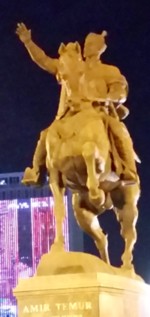Petroglyphs
We would stop for lunch in Navoi (Kermine) but before that, about 45km out, we paused at a high rock outcrop to look at some ancient rock art (petroglyphs).
These are typical of some 140 sites in Uzbekistan thought to have been created by the Neolithic (Stone Age) hunters and fishers of Keltaminar culture who populated this region as the Northern Ice sheet retreated, perhaps 6,000 years ago. We can only guess that the artists' motivation was to support of early animist religious practices; as a means of passing on knowledge to children; or simply as a way of leaving one’s mark. Back then this country was much more lush and better watered and due to climate change and human predation, some of the animals they are depicted hunting have long been extinct here.
One picture suggests another and successive generations of humans have been making images here ever since. Later petroglyphs depict bronze age and then iron age fauna and technology such as bulls and wheeled carriages. Hence they include some painted graphiti that probably goes all the way back to last month. The later appearance of wheeled vehicles is yet another testament to the history of this great trade route, reaching back into pre-history.
The petroglyphs depicting native hunting and extinct fauna - added to over millennia
including paint and crayon graphiti that probably goes all the way back to last month
Navoi
Today Navoi is an industrial town with chemical plants and power stations drawing on local gas reserves. It’s on the Zeravshan River, that we previously saw in Samarkand, with a very extensive irrigation area north east and west. So it’s also a big agricultural centre and transport hub. This was an interesting departure from a seemingly endless diet of similar looking blue tiled Islamic madrasah, mosques and mausoleums. Here was modern secular Uzbekistan with cooling, reflux towers and silos rising above the warehouses and we might have been in the American mid-west.
Navoi
After lunch near the river we again joined the Silk Road. If we’d wanted proof that we were still on the ancient route, about 20 km out of town, adjacent to the airport for contrast, we reached caravanserai Rabati Malik.
Rabati Malik Caravanserai at Navoi
A caravanserai, as I first learned in a comprehension test in High School (the Intermediate or the Leaving Certificate exam?), is a sort of ancient motel, usually fortified against bandits. This one was built about the time William the Conqueror was invading England, across the ancient road from what was probably an even more ancient cistern or well. The recently restored portal is a first stage in the restoration of this World Heritage site that was damaged in various wars then finally flattened in an earthquake in 1968. The UNESCO site tells us (idiosyncratically auto-translated from the French):
| Rabati Malik Caravanserai is constructed according to the order of Karakhanid Shams-al-Mulk Nasr, son of Tamgachkhan Ibragim ruled in Samarkand from 1068 until 1080…
The arch is concluded in the П-shaped frame executed from the carved terracotta in the form of eight-final stars connected with each other, limited by intertwining tapes. Ring is decorated by the Arabian inscription. On overhanging walls, under the layers of repair plaster the rests of ancient ganched plasters with figure of vegetative character are traced. The portal, as well as (like) all caravanserais has been laid out from adobe brick with the subsequent facing backed bricks in size of 25х25х4 cm … The caravanserai occupies – 8,277 sq m. |
Caravanserai Rabati Malik
Elsewhere we learn (from The Great Soviet Encyclopaedia):
| The Karakhanids were a Muslim Turkic dynasty of the Karakhanid state in Middle Asia from 927 to 1212.
Named after the first Khan, Abdulkarim Satuk Karakhan (died 955 or 956), the family descended from the Lagma tribe and bore the title of Bogra-khan. At the head of the Karakhanids stood the Tamgachkhan, or Khan of Khans. The most powerful representatives of the Karakhanids were Nasr (late tenth century), Ibrahim (1046–1068), and Arslan (1102–30). |
To facilitate trade along the Silk Road several such Caravanserai were constructed by the Karakhanids during the 11th century CE. They continued to function until the Silk Road’s relative decline in importance in the 15th century.
Fortunately we have photographs taken before the earthquake. These show that this building once had decorations and architectural features in the Persian style that were extraordinary in a building in Central Asia and attest to the cosmopolitan cultural influences along this route.
Today it's largely rubble. So the most interesting features are the layout of the different spaces; the footings of the fallen columns and the ancient terracotta bricks in the facing walls that are similar to those seen throughout the much more ancient Roman Empire - from York in England to Constantinople (Istanbul). What have the Romans ever done for us?
The nearby cistern is covered by a domed ceiling, also reminiscent of Constantinople. But its water is no longer potable. The irrigation of land around the Zarafshan River has raised the water-table, bringing up salt from ancient seabeds below.
The somewhat restored ancient cistern
There are more images in the Uzbekistan Album - Click Here...
A bedraggled donkey harnessed to disreputable wagon nearby seemed to say it all.
An hour and a half later we reached Bukhara.

